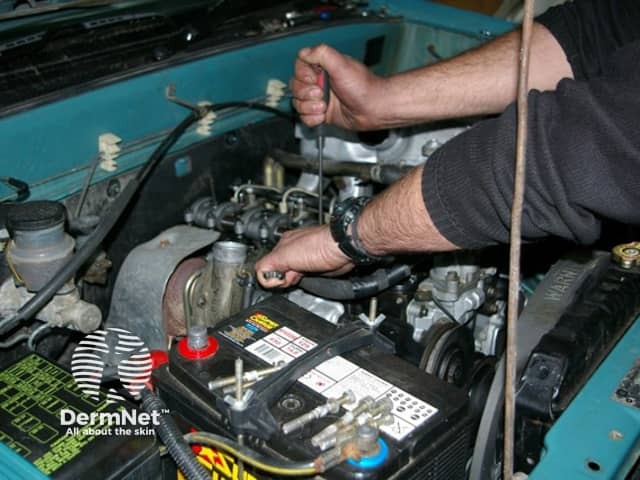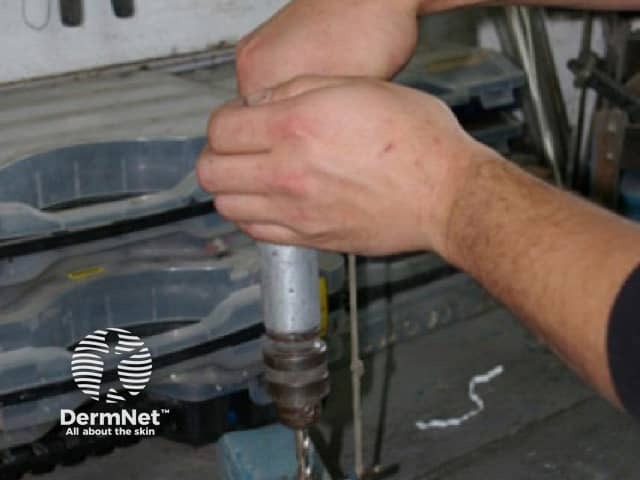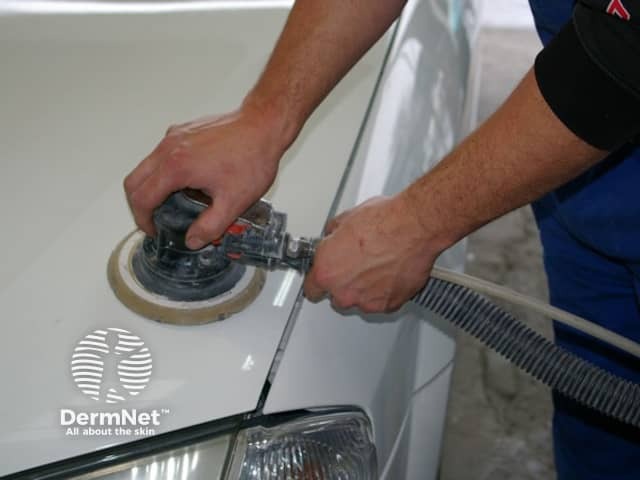Main menu
Common skin conditions

NEWS
Join DermNet PRO
Read more
Quick links
Skin problems in motor vehicle repair workers — extra information
Skin problems in motor vehicle repair workers
Author: Susan Ford BSc (Hons), Occupational Health, 2012.
Introduction
Occupational risks
Skin barrier function
Causes
Irritant contact dermatitis
Allergic contact dermatitis
Acneform rashes
Hand and nail infections
Skin cancers
Leukoderma
Vibration white finger
Workplace risk assessment
Health surveillance
Treatment
Introduction
Occupational hand dermatitis in motor vehicle repair workers is common. Workers in the motor vehicle repair industry may suffer from:
- Irritant hand dermatitis
- Allergic contact dermatitis
- Hand and nail infections
- Vibration white finger (hand-arm vibration syndrome, Raynaud phenomenon)
- Acneform rashes
- Skin cancer
- Leukoderma (white skin).
Why do motor vehicle repair workers have skin problems?
Occupational skin problems in motor vehicle repair workers are mainly caused by:
- Contact with oil, grease, solvents and degreasing agents
- Pre-existing sensitive skin or atopic dermatitis (eczema)
- Exposure to potentially toxic or allergenic chemicals
- Thermal burns
- Microtrauma
- Vibrating power-driven hand tools
- Cold working conditions
- Exposure to ultraviolet radiation.

Car mechanic

Car mechanic

Car mechanic
Understanding skin problems in mechanics
The outermost layer of the skin (the horny cell layer of the epidermis) acts as a barrier to prevent infection and to prevent potential allergens from penetrating the skin. Its pH is slightly acidic which can help to neutralize the degreasing agents that are in soaps, which are alkaline. Excessive use of soaps and some detergents can destroy the acidity and de-fat the surface skin and therefore the protection it offers.
If the moisture content of the skin is too high (overhydrated skin) or too low (dry skin), the skin’s barrier function may be impaired. Air-conditioned environments with low humidity will cause the skin to dry out, becoming rough, thickened and flakey. This eventually leads to cracking of the skin because of loss of elasticity. Over-hydration of the barrier layer from prolonged contact with water, or from sweating inside gloves also results in dry skin, since impaired barrier function allows moisture in the skin to evaporate away.
How does occupational skin disease occur?
Occupational skin disease may occur in the following circumstances:
- Mechanical injury or chemical injury to the skin damages the skin’s defensive barrier layer, rendering the skin more susceptible to further mechanical or chemical injury.
- Damage to the barrier layer increases the risk of infection, and also increases the risk of developing contact allergy, since potential allergens can gain access to the immune-competent cells in the deeper layers of the skin. Some foreign substances gain access to the skin via sweat ducts or hair follicles, by-passing the skin barrier.
Irritant contact dermatitis
Irritant contact dermatitis is the name given to inflammation of the skin resulting from direct contact with a chemical or physical agent that damages the skin. Examples of irritants include:
- A wide range of industrial chemicals used in the motor vehicle repair industry, including heavy metals contained in brake fluids, degreasers, detergents, oils and lubricants, metal cleaners, paints, liquid fuel, solvents, adhesives, antifreeze, epoxy resins and nickel
- Particulates from sanding, glass fibre
- Cold conditions and low humidity causing dry skin and chilblains
- Microtrauma (abrasions)
- Exposure to ultraviolet radiation (solar UVR and arc welding).
The features of irritant contact dermatitis are varied.
- It may be a single episode that recovers, repeated relapsing episodes, or chronic dermatitis due to repetitive injury.
- In general, the degree of damage following irritant exposure depends on the potency of the irritant, the duration of application, the frequency of exposure, occlusion, temperature, anatomical site, and individual susceptibility.
- Where there is repeated exposure, previous damage may render the skin more susceptible to damage from the next exposure. However, hardening may also occur.
- Because contact irritant dermatitis is dose-dependent, it tends to be restricted to the site of primary contact, which is usually the hands. A reduction in the cumulative exposure to irritants lessens the risk of dermatitis. Conversely, occlusion of the irritating chemical(s) or particulates by gloves, jewellery ( such as wedding rings ), or wristwatch can aggravate dermatitis.
- Dermatitis may be dry, flaking, and fissuring; or erythematous, swollen, blistering, weeping, and eroded.
- Broken skin leads to a risk of skin infection (impetigo), presenting as red, painful, swollen skin with ulceration, oozing or pustules.
Allergic contact dermatitis
Allergic contact dermatitis is an immunological response (allergy) to a contact allergen, such as nickel in tool handles such as spanners and wrenches, or epoxy hardeners found in body fillers and sealants. Only people who are allergic to a specific agent (the allergen) will show symptoms. The appearance can be exactly the same as irritant contact dermatitis and often co-exists with irritant contact dermatitis. There are some specific features of allergic contact dermatitis.
- The allergen may have been previously tolerated for years without causing dermatitis.
- Once sensitised the reaction may occur with minimal exposure to the allergen.
- Dermatitis may occur not only at the site of primary contact, but also at secondary sites, such as a person who is allergic to rubber gloves may get dermatitis on their hands, and on the face or neck, where they transferred tiny amounts of allergen by accident.
- Dermatitis occurs within hours or days of exposure to the allergen.
- Symptoms settle down when the skin is no longer in contact with the allergen, although this may take weeks and require treatment.
- Allergic contact dermatitis can be confirmed by patch tests.
Acneform rashes
Exposure to industrial oils, grease or cooling agents can cause oil folliculitis (inflamed hair follicles) and comedones (blackheads and whiteheads). These conditions appear on any area of the body where there is excessive oil on the skin or clothing, commonly the forearms and thighs.
Hand and nail infections
Hand dermatitis, wet work and trauma causing a break in the epidermis, predispose to yeast infection, usually presenting as chronic paronychia infected by Candida albicans or as intertrigo between the fingers also called erosio interdigitalis; whereas bacterial infection (impetigo, boils and folliculitis are usually caused by Staphylococcus aureus and/or Streptococcus pyogenes.
Skin cancers
Skin cancer is sometimes associated with the motor vehicle repair industry.
- Thermal burns and chemical burns in the motor vehicle repair industry can be due to contact with hot surfaces, e.g. exhaust pipes or hot-melt chemicals, sudden release of hot water and steam lines, radiator and cooling system pipes, soldering and welding operations. Scarring will result if the dermal layer of the skin is affected. In some cases, and mostly associated with chronic burn wounds, malignant changes in the form of a Marjolin ulcer (a highly aggressive squamous cell carcinoma) have been known to occur in areas of previously traumatised, chronically inflamed or scarred skin. Basal cell carcinomas may also occur in scars such as welding burn scars.
- Repeated exposure to waste engine oil and petroleum-based chemicals (petrol and diesel) may cause skin cancer
- Arc welding operations result in UVR exposure, which may also cause skin cancer.
Leukoderma
Contact leukoderma (sometimes spelt leucoderma), or white skin, occurs when the melanocytes (the pigment-producing cells) are selectively destroyed. Although it may look similar to vitiligo, leukoderma is due to toxic effects on the melanocytes, whereas vitiligo is an autoimmune process. Leukoderma may follow skin contact with chemicals such as phenol, and phenolic resins may be found in brake pads, brake shoes and clutch disks.
Vibration white finger
Vibration white finger, also known as hand-arm vibration syndrome, is one cause of Raynaud phenomenon. Vibration white finger is caused by repetitive injury from handheld vibrating tools such as sanders, polishers and air chisels. The length of exposure before symptoms develop varies from months to years, and the risk of symptoms increases with the intensity and duration of exposure. If exposure to vibration is not reduced at an early stage in the disease, permanent damage may arise. Specific features and symptoms of vibration white finger include:
Specific features and symptoms of vibration white finger include:
- Tingling and numbness in the fingers
- Reduced grip strength
- Fingers become white (blanch) when cold, and red and painful on rewarming.
Workplace risk assessment
Workplace risk assessments identify ‘hazards’ (anything that has the potential to cause harm) and ‘risk’ (the likelihood of an event occurring). The aim should be to reduce these, as sickness absence from work can be prolonged and costly. Ill health can adversely affect the quality of life; the ability to work in a chosen industry; insurance costs and litigation claims. A generic risk assessment in any motor vehicle repair establishment should include a specific section on skin exposure and should cover:
- Hazardous properties and adverse health effects from the exposure to chemicals
- Hazardous properties of vibrating tools
- Frequency and duration of exposure
- Controls and their effectiveness
- Personal protective equipment.
Staff education and training should include:
- Familiarity with the Material Safety Data Sheets for chemicals used in the workplace
- Information regarding the safe use and maintenance of tools used in the workplace
- Skincare education
- Reporting of accidents/incidents/ occupational health problems
- Correct use and maintenance of personal protective equipment.
Results of workplace risk assessments must be recorded and kept.
Health surveillance
Health surveillance should be carried out when a workplace hazard is minimised rather than eliminated. Staff should be encouraged to report any signs of skin problems and all reasonable steps should be taken to resolve the problem and prevent recurrences. This may involve a referral for medical advice.
Good general advice for motor vehicle repair workers
- Substitute less hazardous chemicals where possible.
- Ensure appropriate ventilation for airborne toxins and potential allergens such as epoxy chemicals and isocyanates, and particulates from sanding and grinding.
- Vibrating tools should be in good working order and suitable for the job. Choose low vibration makes/models where appropriate. Use anti-vibration gloves as appropriate. Take breaks.
- Use personal protective equipment such as gloves, facemasks, eye protection, respirators and overalls as appropriate to the job.
Good hand care advice for motor vehicle repair workers
- Use personal protective equipment according to manufacturers' instructions.
- Remove skin contaminants by washing with clean warm water before eating, drinking, smoking or using the lavatory.
- Use the mildest cleanser required to get the job done. Never clean hands with concentrated cleaning products, solvents or fuel.
- Barrier creams used before work may be appropriate in some circumstances, to make skin cleansing easier.
- Use moisturising creams after work and after washing hands.
- Regularly change soiled overalls.
- Never keep oily rags in pockets.
- Report skin problems to management.
Treatment of occupational skin disease
Management of hand dermatitis in a motor vehicle repair worker may include the following:
- Taking a full history of the work undertaken to identify possible causes of the dermatitis
- Minimising contact with irritants (eg, solvents, dust, water)
- Avoiding known allergens
- Optimising skin barrier function with suitable emollients, barrier and moisturizing creams applied frequently during work and at home
- Applying potent topical corticosteroids to dermatitis flare-ups
- Prescribing antibiotics for secondary bacterial infection.
References
- Dixon AJ, Dixon BF (2004) Ultraviolet radiation from welding and possible risk of skin and ocular malignancy. The Medical Journal of Australia (2004) 181 (3): 155-157
- Fisher A (1986) Contact Dermatitis Third edition p-676 Lea and Febiger Philadelphia
- HSE (2006) Work involving motor vehicle fuel (Diesel, petrol and LPG) SR16
- HSE (2007) Control of isocyanate paint exposure in motor vehicle repair (motor vehicle repair) body shops Disease Reduction Programme Version 7 P 6,12
- HSE (2008) Work Related Contact Dermatitis Topic Inspection Pack Disease Reduction Programme (DRP) Skin Disease Programme Version 4
- HSE (2009) Health and Safety in Motor Vehicle Repair and Associated Industries. ISBN 978 0 7176 6308 8 P 84-86.
- HSE (2011) Work with Lubricants and Waste Oil SR19
- Lifeso RM, Rooney RJ, El-Sahker M (1990) Post-Traumatic Squamous-Cell Carcinoma. Journal of Bone and Joint Surgery P12-18
- Moen B E, Holland B E, Torp S (1995) A Descriptive Study of Health Problems on Car Mechanics’ Hands Occupational Medicine Vol 45 No 6 pp 318-322 1995
- Petrie EM (2012) Nitrile-Phenolic Adhesives. http://www.specialchem4adhesives.com/home/editorial. Accessed June 2012
- Isocyanate (2-pack) paints – Health and Safety Executive, UK. Accessed June 2012
- Controlling the risks from hand arm vibration – Health and Safety Executive, UK. Accessed June 2012
On DermNet
- Hand dermatitis
- Allergic contact dermatitis
- Irritant contact dermatitis
- Oil folliculitis
- Leukoderma
- Comedonal acne
- Raynaud phenomenon
- Mechanics hands in antisynthetase syndrome
- Personal protective equipment
Other websites
- Health and safety in the motor vehicle repair industry – Health and Safety Executive, UK
